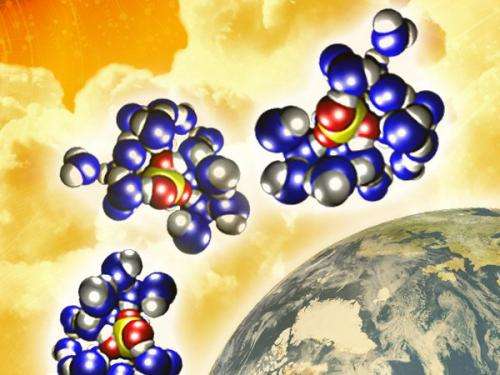Bytes for bits: Researchers develop a new, efficient aerosol module for climate models

(Phys.org) -- Thinking small, scientists achieved big impact. Pacific Northwest National Laboratory researchers led a team developing a new computational module to depict tiny atmospheric particles that have a large effect on climate. Coming closer to a realistic depiction of these atmospheric bits, "MAM," short for Modal Aerosol Module, also achieves a new level of computational efficiency. Developed for the atmospheric component of the Community Earth System Model version 1 (CESM1) used for the Intergovernmental Panel on Climate Change 5th Assessment report, the minimal MAM representation means a big impact for climate modeling.
"MAM balances a realistic treatment of aerosol physiochemical properties and processes and the need for computer efficiency in climate simulations. Because CESM1 is a community climate model, MAM has generated a significant impact in both aerosol and climate communities," said Dr. Xiaohong Liu, lead author of the study and atmospheric scientist at PNNL.
Tiny but mighty. Aerosols are bits of dust, soot, and chemicals in the air that are intensely scrutinized by scientists because they affect climate and weather in so many big ways. These multi-talented specks can absorb or scatter the sun's energy and change what happens inside clouds. Considering the many complex and sometimes conflicting climate effects, PNNL scientists have developed a new representation to account for aerosols efficiently and accurately within one of the leading global climate models. This scientific advance will help provide a clearer picture of the future climate.
A major challenge for scientists working with global climate models (GCMs) is how to realistically represent aerosols, and all their complex properties and processes, within the limitations of computational resources. Achieving a minimal representation of aerosol in GCMs to capture the essentials of how aerosols affect the climate is highly desirable.
A research team, led by Liu, developed two MAM versions for the Community Atmospheric Model (CAM5): a complete 7-mode version and a simplified 3-mode version and compared them to observations. First, the complete 7-mode version was developed as a benchmark used in detailed studies. From the 7-mode version, the scientists developed a 3-mode version to use in decade- to century-long climate simulations. By evaluating both versions with a collection of observation data obtained from surface stations, aircraft campaigns, and satellite measurements, the researchers showed that the simplified 3-mode version achieves the goal of a computationally compact representation of aerosol's effects on climate. Compared to earlier aerosol modules in CAM, MAM is capable of simulating the aerosol size distribution and has a more realistic representation of mixing states between aerosol components. Both features are critical for capturing the aerosol direct and indirect effects on climate.
MAM has been well received by the modeling community. It has been implemented in the Weather Research and Forecasting Model, a major regional model for weather, air quality, and climate studies. MAM was adopted by the National Aeronautics and Space Administration (NASA) Goddard Earth Observing System Model, version 5 (GEOS-5) for NASA's satellite data assimilation, climate modeling, and air quality studies.
Researchers next will improve the cloud and aerosol representations in CAM5 responsible for the modeled aerosol biases, in collaboration with scientists at the National Center for Atmospheric Research and Lawrence Livermore National Laboratory. For example, in a related study supported by another U.S. Department of Energy (DOE) climate modeling project, known as the Polar Project, scientists are improving the low-level cloud cover estimations and processes affecting aerosols transported to the Arctic region.
More information: Liu X, et al. 2012. "Toward a Minimal Representation of Aerosols in Climate Models: Description and Evaluation in the Community Atmosphere Model CAM5." Geoscientific Model Development 5(3):709-739. DOI:10.5194/gmd-5-709-2012
Provided by Pacific Northwest National Laboratory




















